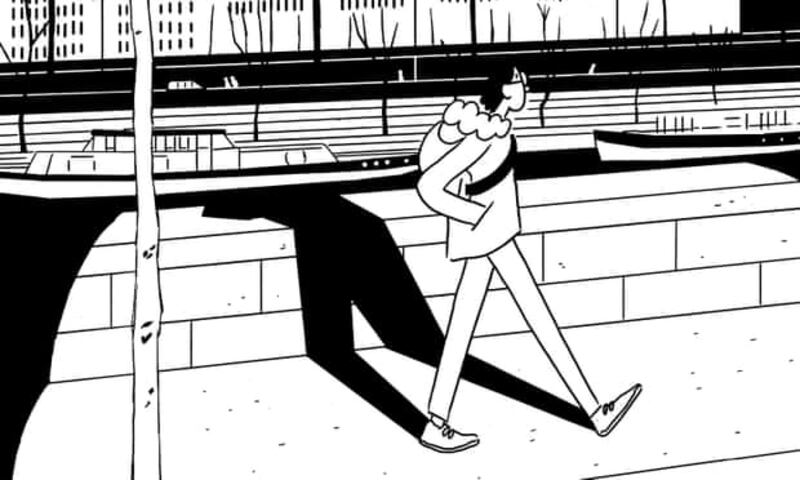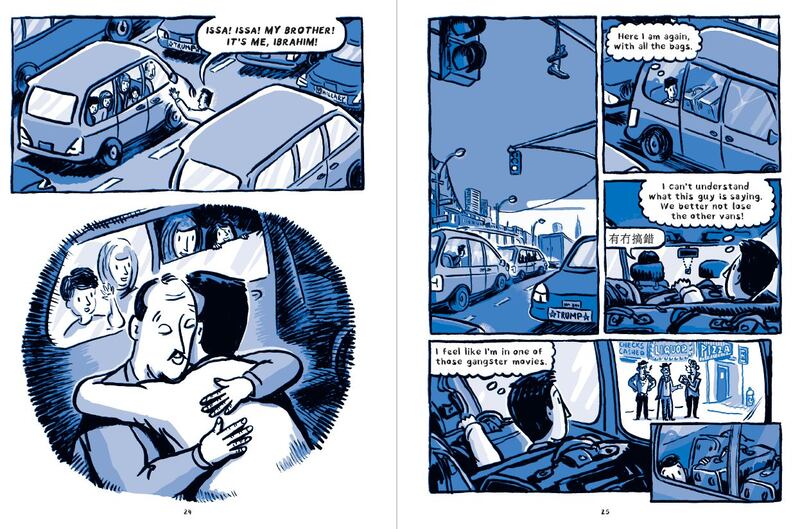Publishing delays, a distracted media and the absence of trade fairs have wrought havoc on publishing in 2020, comics and graphic novels especially. Despite all this, it’s been a bumper year for probing, insightful, personal, hilarious and gruesome works from a dazzling variety of writers and artists. If this tidal wave has passed you by, here are six must-read graphic novels which might help make this annus a little less horribilis.
When Sophie Yanow was a student, she set off from Paris for a hitch-hike across Europe. On this trip, which forms the basis for The Contradictions (Drawn & Quarterly, €23.99), she's accompanied by her new friend Zena, a charismatic, fixie-bike sporting anarchist. This warm, funny coming-of-age tale explores privilege, capitalism and sexuality without ever seeming preachy or didactic. The Contradictions won an Eisner award as a web series but the story works just as well at novelistic length as Yanow's knowing dialogue and clear line style bring her plot to life with unfussy panache.

This is a book filled with small moments of discovery. Yanow is a master at wringing achingly funny depictions of the awkward, sometimes insufferable pretensions of student life while also conveying a real empathy for those who express them. A lesser author might over-egg the characters’ circular agonising, their endless navel-gazing around the morality of capitalism or their own yawning privilege, but Yanow takes her time to show the virtue of these principles and the people who hold them, where others might have made them insufferable cliches.

The Contradictions’ characters are, yes, contradictions. But while they may be cartoons they’re never caricatures.
It's hard to know what to say about Olivier Schrauwen, Florent Ruppert and Jérôme Mulot's Portrait of a Drunk (Fantagraphics, $29.99/€25.35). No description seems adequate and any attempt risks spoiling its fantastical effect.
Sticking with the front cover, the gurning face that greets you – for my money, one of the most purely enjoyable images ever committed to print – belies the dark, rotten heart of the story’s titular lush. Our protagonist, Guy, is indeed a drunk but he may also be one of the most reprehensibly amoral characters you’ll meet this year; a ship’s carpenter by trade, an alcoholic by habit, and an utter bastard by something like vocation.


The book follows Guy as he blithely cheats, lies, murders and steals his way through 18th-century France, its overseas colonies and the wide blue oceans between. We also meet the souls of his departed victims, cursed to watch his shabby misadventures through an ever-shrinking aperture in purgatory, whence they narrate his activities in the manner of a slowly decaying Greek chorus of corpses.
Things only get stranger from there but, suffice to say, the book’s all the better for every gruesome and gristly bit of it. Portrait of a Drunk is an utterly compelling, startlingly original and bleakly hilarious book. Rarely, if ever, has ugly been so beautiful.
Dubliner Luke Healy's memoir Americana (Nobrow, £16.99/€18.90) depicts the cartoonist's 2016 trek from Mexico to Canada along the Pacific Crest Trail, a 2,600-mile hike that spans the US's entire west coast. This is, in a very literal sense, a book about distance whether that be length between checkpoints on a dusty path or the emotional gulfs between people seeking splendid isolation on this arduous, sometimes punishing, journey. It's a long, long road but Healy is, fortunately, a delightful companion and succeeds at capturing the struggles – and solace – inherent in walking for an extremely long time for no good reason.

Americana’s pace fits its theme. Stately and measured without ever being ponderous, it allows space for a hundred quiet little character moments that reveal a writer of true craft. Healy’s cartoony drawings are so beautifully rendered, you might only realise afterward that every single one is hued entirely in the red, white and blue of his host nation. It’s a long book but you stand a good chance of loving every page. One of the finest bits of graphic memoiring you could ever pack in a 12kg knapsack.
Carrasco's fluid, inky, black and whites melt time and space in your hands
Dominican-born Toronto citizen Freddy Carrasco is redrawing science fiction with Gleem (Peow Comics, $26/€22) an all-black, Y2K-futurist landscape of religious visions, dance-floor ecstasy and intermittently explosive robots. Gleem drops you very much in media res with little by way of introduction or exposition and sends you falling, tripping, bending and flying through its futuristic vistas, extending for pages at a time with little dialogue.
The result is as captivating as it is bracing, following lead character Femi through three stages of his life: accidentally imbibing narcotics at a religious service; attempting to replace a much-loved android; and experiencing the wordless, hallucinatory intensity of a space-age rave confined to a nightclub bathroom stall. The first and third of these, in particular, show an uncanny awareness of movement and action as Carrasco’s fluid, inky, black and whites melt time and space in your hands. The effect is as close to moving images as the printed page allows.

If that all sounds bewildering, it’s barely the half of it. Gleem offers that captivating feeling common to all great sci-fi: a sense that its world expands above and beyond the page, inviting us to view just one small glimpse at its reality at a time. And it’s time well spent so expect to read and reread it until time and space fold back on themselves anew.
In 2016, Pultizer-winning journalist Jake Halpern set out to find a family of Syrian refugees. He went on to tell their story in a series of short segments for the New York Times, along with illustrator Michael Sloan (who, not to be outdone, boasts a separate Pulitzer of his own). That family was the Aldabaans of Homs, and the entire series is now collected in Welcome to the New World: Waking Up in Trump's America (Bloomsbury, €20.25).
The Aldabaans land in the US on the eve of Trump’s election in 2016 having fled Syria for Jordan some years before. Welcome to the New World begins by sensitively capturing the drama of their exile before shifting to the humdrum bureaucracy and hardship that ensues for them as fledgling Americans.
Dad Ibrahim is an educated professional wracked with guilt about leaving elderly relatives and beset by stress for the wellbeing of the family he has brought halfway across the world. His teenage son Naji is uncertain of his place in a new society and the risks and opportunities it affords, from working in Dunkin’ Donuts to, horror of horrors, speaking to girls.
Both struggle with the traumas they carry from Syria – war, persecution and, in Ibrahim’s case, imprisonment and torture – but Welcome to the New World is particularly deft in its depiction of the more quotidian hardships of arriving in an unfamiliar place. We see them react to racist threats and discover American homes are missing the bidets they’re used to.
The book retains most of the real, recorded speech of its subjects so its dialogue has a pared-back, declarative style which could seem flat or even stilted in other hands. Here, however, your ear soon tunes to the documentarian tone allowing Halpern and Sloan to deliver many unexpected notes of lightness and irony en route, not least in the cast of strangers who extend their kindness to their new neighbours. Welcome to the New World has its fair share of heartbreak, but doesn’t scrimp on hope either.
That you grow to love every scratchy, scribbly drawing is a tribute to Nobles's art
If you like your family memoirs a little more riotous, Danny Noble's Shame Pudding (Street Noise, $16.99/€18.90) may just well be the dessert you ordered. It tells the story of Noble's humble clan starting with her grandparents' generation of Polish Jewish emigres (to Hull and later Brighton) who populate family meals, funerals, weddings and religious holidays. From there, we progress to the Sturm and Drang of school, football terraces and Noble's eventual entry into the wider world.
The book’s early passages are told from the point of view of the author’s infant self, framing big-picture family dramas within the instinctive, intuitive logic of a child. It’s exhilarating to trace a six-year-old’s description of “great-aunts with large glasses” or “uncles with massive ears” and feel the tracks of their train of thought beneath your feet. That it manages to do so without ever becoming obtuse or self-conscious is testament to Noble’s skill as a writer. That you grow to love every scratchy, scribbly drawing is a tribute to her art.

This is a book that exudes gigawatts of warmth all while providing more laugh-out-loud moments than most out-and-out comedies. The title itself stems from the term of endearment used by Noble’s grandmother for her grandchildren, a mispronunciation of the Yiddish “shayn punim” or “beautiful face”.
Like the phrase itself, Shame Pudding is a sincere and lovely thing which, even when it translates to something silly or absurd, never loses its sweetness.


















